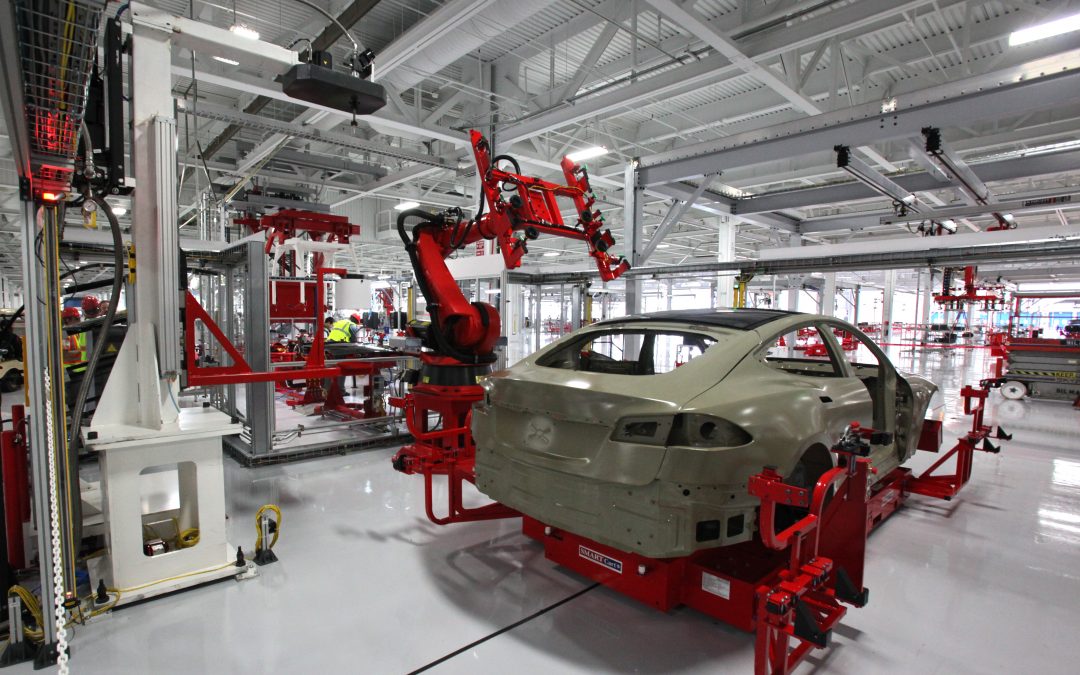
by Fronetics | Feb 18, 2016 | Blog, Strategy, Supply Chain

The health care supply chain could cut billions of dollars in cost by adopting practices well established in other industries.
Take the case of a typical Asian laptop manufacturer, for example. As a result of a top-notch supply chain, a European customer can place an order and receive a pallet of freshly assembled computers in just over a week. Ask a pharmaceutical manufacturer for a delivery, on the other hand, and the lead time stretches to 75 days.
The case is further illustrated by the difference in operational metrics between the health care supply chain and the supply chain for fast-moving consumer goods (FMCG). Whether you look at days in inventory, obsolescence, or manufacturing lead time, the FMCG is invariably so efficient that the health care supply chain looks sluggish in comparison.
But such a significant performance gap also means even minor efficiency gains could have a big impact, according to a McKinsey report. An industry that spends in the excess of $340 billion annually on pharmaceuticals and medical devices would benefit from examining every part of its supply chain to not only speed up lead time and boost ROI, but also provide safer and more affordable products to end customers around the world, the consulting firm argues.
The shortcomings so far stem from an inability to tackle challenges that today add substantial cost to the health care supply chain. Big-ticket challenges include:
- Increased regulatory scrutiny
- Expanding product portfolios
- Drug recalls
- Drug shortages
- Counterfeiting
- Supply-chain security breaches
- Medication errors in the developed world
Although transforming a supply chain is an incredibly complex undertaking, McKinsey notes:
“…if the sector adopted straightforward advances well established in other industries, we estimate that total costs (from the supply chain and external areas, such as patient care) could fall by $130 billion.”
Industry research does indeed show every member of the value chain – from pharmaceuticals and medical suppliers to pharmacies and hospitals – that embraces opportunities to optimize the health care supply chain reaps the rewards in increased profitability. In most cases, the impact on profits ranged from 10 to 20 percent.
So which area of the supply chain offers the greatest opportunity for improvement?
Senior supply chain executives in the pharmaceutical and medical device industries overwhelmingly place improved collaboration at the top of the list. To overcome cultural barriers and make transactional relationships more productive, McKinsey suggests the following approach:
“…six essential steps can make the difference between a productive collaboration and a frustrating one: companies must collaborate in areas where they have a solid footing; agree on sophisticated benefit-sharing models; select partners for the potential value of the collaboration, as well as their capabilities and willingness to act as a team; dedicate resources to the collaboration and involve senior leadership in it; jointly manage performance and measure impact; and start out with a long-term perspective.”
Collaboration is still only a small piece in the supply chain puzzle that also includes better market, product, and customer segmentation; greater agility; improved benchmarking and measurements; and the establishment of global standards for data exchange. To put it all together, it is imperative for the health care supply chain to follow the lead of high performing industries.
You may also like: Improving Efficiency in the Healthcare Supply Chain

by Fronetics | Feb 17, 2016 | Blog, Content Marketing, Manufacturing & Distribution, Marketing, Social Media, Supply Chain
 The US manufacturing index is at its lowest level since 2009. This is sobering news for the industry and for the economy. Within the industry, it is clear that the road ahead is not flat, straight, or even smooth. For companies to not just survive, but to also succeed, action needs to be taken.
The US manufacturing index is at its lowest level since 2009. This is sobering news for the industry and for the economy. Within the industry, it is clear that the road ahead is not flat, straight, or even smooth. For companies to not just survive, but to also succeed, action needs to be taken.
In August 2015 Bruce McDuffee, Principal at Knowledge Marketing for Industry, released the second edition of the Manufacturer’s Growth Manifesto. If you haven’t read this, you need to do so – today. In the Manifesto, McDuffee spells out how manufacturers can achieve growth rates of 10%, 20%, and even 30%.
The key to attaining a double digit growth rate is changing your marketing strategy and adapting to buyers’ new habits. Specifically:
- Stop pitching products and start helping people.
- Start educating your audience utilizing your particular experts and expertise for FREE.
- Stop advertising product features and benefits of a product.
- Start promoting your useful, helpful papers, webinars, seminars, videos, etc. (not product information) to foster meaningful engagement.
- Admit to yourself and your team that your products are perceived as a commodity and it will take more than product revisions, releases and enhancements to gain the attention of your target audience.
McDuffee concedes that for those who have not previously embraced and engaged in this approach to marketing, “You may be thinking, WTF?”
It may seem counterintuitive, but the results are real. Your company will be able to achieve those double digit growth rates and realize these benefits:
- Reciprocity, credibility and trust in the minds of the people in your target audience.
- Top-of-Mind Awareness (T.O.M.A.) in the minds of your prospective customers so they remember your firm first when the day comes around and they need to buy.
- Higher prices, more sales, more market share, and higher growth rates.
Success, however, depends on believing in this approach and incorporating it into your overall business strategy.
Research conducted by the Content Marketing Institute (CMI) found that while 82% of manufacturers use content marketing, only 26% say that their efforts are successful. A lack of buy-in/vision from higher ups is one of the key challenges identified by CMI. Another challenge that was reported was creating and executing a strategy; only 20% of respondents reported that they had a documented strategy. Notable though, is that 58% of the most effective companies reported that they have a documented strategy.
This approach is not relevant only to manufacturing. Companies across industries and verticals should take notice. Cerasis, a top North American third party logistics company offering logistics solutions with a strong focus on LTL freight management, shifted their marketing strategy and realized positive results. Within 25 months Cerasis realized a 14% increase in revenue. This increase was directly attributable to inbound marketing. In addition to this stream of revenue, the company’s sales team was able to generate revenue totaling $20 million during this period – more than double the previous two years combined.
Those numbers are not small potatoes. If you haven’t checked out the Manufacturer’s Growth Manifesto, make the time.
You may also like:
This was originally published on Electronics Purchasing Strategies.

by Fronetics | Feb 16, 2016 | Blog, Logistics, Strategy, Supply Chain

Interim management is an opportunity.
These days there may be no such thing as “business as usual.” People no longer work for one company for decades and then retire with a pension. Most will work an average of 10 jobs before the age of 40, according to Bureau of Labor Statistics, and that number is predicted to increase over time. Given this fact, it makes sense that, even at the high levels, job consistency is not a given for any one person or any company.
Interim management is an opportunity for companies to handle transition in an optimal way. There are numerous benefits that are cost-effective and efficient.
Organizational continuity
A company can hire someone to come in and specify exactly how they would like to progress in the interim. Demanding status quo, in many ways, may be what the company needs until assessments and next steps are made. The interim manager’s experience can help stabilize public image and alleviate some employee fears.
Choose for specific needs
If continuity isn’t the desired route, the benefit of interim management is that a company can seek specific needs in interim management that fill the holes and address the challenges of outgoing management. If a change is needed, that is possible, too.
Independent thought & experience
Interim management companies work to benefit you and you alone. Of course they gain in some ways, but they are independent from allegiance to other companies and are hired to keep your best interests in mind. It benefits them, in the long run, to serve your specific needs. You can be assured that they aren’t in for a long-term position.
Flexible assignments
A company can hire interim management for however long is necessary. The flexibility of the engagement works well for everyone. Interim management are prepared to work themselves out of the job, genuinely equipped to find the best people for the support role positions and/or an executive replacement. An interim professional can also help navigate unique challenges, act as a board advisor, or offer expertise on special projects and initiatives. They provide effective and efficient talent for the necessary amount of time.
Time to search for candidate
Time, if nothing else, is to be gained here. If an executive becomes ill or leaves unexpectedly, interim management can come in swiftly and deftly take over, allowing for time and space to search for the best replacement candidate.
In a Forbes article about interim executive models in modern management, the author writes, “[G]iven all these benefits, I think companies should be a bit more creative about the way they move people into and out of executive roles.” Interim management is smart. It’s the way of the future in a fast-paced job market.
Fronetics offers management and leadership solutions to organizations within the supply chain and logistics industries during times of transition. Our Fronetics Interim Retained Management Service (FIRMS) is designed to provide specific executive, management, sales or operational expertise when and where you need it, for exactly as long as you need it. By using FIRMS for your interim management needs, you will be able to fill organizational knowledge gaps, minimize disruption, and create positive change for your organization during times of transition.
Related

by Fronetics | Feb 15, 2016 | Blog, Marketing, Social Media, Strategy

When you are posting on social media could be as important as what you’re posting.
Timing is everything, and that statement especially holds true when it comes to posting content to social media. If you are sending out your message and nobody is there to see it, you are that proverbial tree falling in the forest; you did not make a sound. Your post had little to no impact.
So, even if you are putting in the time and effort to craft informative blog posts, tweets with just the right message, or Facebook posts that inspire more than just page likes, you still are not getting the most exposure you can out of social media.
Data that delivers results
According to research by social media scientist Dan Zarrella, when you are posting your content can be almost as important as what you are posting. Luckily, there is an ample amount of analytical data out there regarding optimal times to post on Facebook, Twitter, LinkedIn, Pinterest, and Instagram.
For example, looking at broad-based Twitter engagement, research suggests that users go up by 30 percent on weekends, speculatively because more people are on their computers, smartphones, and tablets during their free time. On weekdays, this peaks at 4 p.m. EST, perhaps as people check into social media as the workday begins to wind down and they are seeking a diversion.
Some studies suggest that Twitter use often peaks slightly earlier, between 1 and 3 p.m. on weekdays, and this might be attributed to people who take an extended lunch break.
LinkedIn studies show that the optimum times to post content are Tuesday through to Thursday during normal work hours. Also noted: Tuesday 10 to 11 a.m. is known to get the most clicks and shares.
When it comes to Facebook, another marketing study suggests that there is quite a wide range of variables, and it is really based upon your audience. But, in general, the best time to post on Facebook is 3 p.m. on Wednesday. Other popular times include 1 to 4 p.m. on Thursdays and Fridays, and lunchtime (12 to 1 p.m.) on weekends.
There are poor times to post on Facebook, too, such as weekends before 8 a.m. and after 8 p.m., according to SurePayroll’s research.
Research supports that B2B content generally performs 16% better during typical business hours, while B2C content performs 17% better on weekends.
Your (personal) optimal posting time
But, the problem with these suggestions is that they are just statistical generalizations of when might be the optimal time for posting content. What you need is analytics that are specific to your particular followers. Your audience maybe a different demographic than those represented in these studies, and when they are reading, sharing, or retweeting may actually surprise you.
You can access personalized data regarding the social media habits of your readers and followers through analytic programs like Google Analytics and sites like Tweriod. There are a wealth of available free tools, which provide valuable insight regarding your audience.
Here are a few to consider:
- Tweriod is a free Twitter tool that helps you know the best time to tweet. The free analysis will analyze up to 1000 of your followers. Tweriod is not part of Twitter but rather is something you may access to better understand your followers’ schedules and interests, like what they have retweeted.
- Followerwonk can help you to individuate your potential Twitter audience by learning not only who follows your competitors, but who commonly retweets their content. You can also look at your own personal audience and discover what content they like, share, and maybe even link to from other posts, as well as when they are most active on social media.
- Facebook Insights tells you the best times and days to post content by accessing your page’s insights in the posts sections. In the graph section for “When Your Fans Are Online,” you can see the days and times when your fans are using Facebook. This data is constantly updated.
- Google Analytics provides insights, analytics, and data regarding your website, and it lets you do more than measure sales and conversions. It also gives insights into how visitors find and use your site, what they are clicking on, and how to keep them coming back.
Many people still play a guessing game when it comes to deciding the best time to post their content for the most impact. But, studies suggest the average life of a tweet is only about 18 minutes. So, if you tweet something during an inactive period for your Twitter audience, you are probably wasting your time.
Posting the right content, at the right time, can make the difference between getting valuable comments, shares, and clicks on your links, and it can provide a myriad of valuable new leads.
Related posts:

by Fronetics | Feb 12, 2016 | Blog, Strategy, Supply Chain
In 2013, Iceland’s oldest shipping company, Eimskip, moved the company’s North American port of call from Norfolk, Virginia, to Portland, Maine.
“Eimskip’s move to Portland was driven by the state’s commitment to investing in intermodal infrastructure and the cultural similarities between Maine and Iceland,” states Larus Isfeld, managing director at Eimskip USA Inc. and Eimskip Logistics Inc.
Culture is not rhetoric for Eimskip. This key player in worldwide reefer logistics has placed a high value on culture since it was founded in 1914. “When identifying where we operate,” says Isfeld, “we look to smaller communities where there are cultural similarities and where we can make connections and be involved.”
Eimskip makes great effort to integrate itself into all aspects of the communities in which it operates, and strives to foster connections across its operational reach. One of the ways the company has traditionally done this is through art.
For many years, Eimskip operated mixed passenger and cargo vessels and would allow artists to pay their way with their work. Over the years, Eimskip amassed a large collection of art.
When asked about this initiative, Isfeld describes the value the company places on artists and their work: “Artists make life more interesting. They also relay certain messages in a much better way than an ad.”
Interestingly, the move to Maine has reignited Eimskip’s investment in artists.
In September 2015, Maine artist Justin Levesque traveled from Portland to Reykjavik aboard Eimskip’s MV Selfoss. His multimedia project ICELANDX207 documented the nine-day journey and captured both stories and profiles of crew members.
Currently aboard the Selfoss are Jonathan Laurence and his business partner, Anneli Skaar. Laurence, a multi-artist and Maine native, is the creative director for the Center for Maine Contemporary Art (CMCA) in Rockland, Maine. Skaar is a Norwegian-American artist, graphic designer, and writer. Laurence and Skaar are also co-founders of TIMBER + ICE, which serves as a creative liaison for organizations that wish to create cultural content to enhance their involvement in the emerging, and quickly evolving, relationship between Maine and the North Atlantic countries.
In keeping with tradition, both Laurence and Skaar will create a piece of art during their passage and donate it to the Eimskip collection. Going forward, TIMBER + ICE will continue to work with Eimskip as cultural liaisons. (You can follow their passage on the Selfoss via TIMBER + ICE’s Instagram and Facebook page.)
Further, TIMBER + ICE plans to create an art installation in Portland to coincide with the U.S. State Department’s Arctic Assembly being held October 4-6, 2016. About 250 delegates are expected to attend the meeting, including scientists, business leaders, and senior government officials from eight Arctic nations. U.S. Secretary of State John Kerry and the heads of state of Arctic nations may also attend.
The installation will utilize shipping containers as exhibition space, and will connect Icelandic and Maine artists in order to highlight, spotlight, and educate — through creative means — the opportunities and challenges related to Arctic issues.
In just three years, Eimskip’s relocation to Portland has fostered a meaningful connection between the two communities — and enriched both with its investment in local artists and their art. It’s exactly what Iceland’s oldest shipping company is all about.
“We believe that businesses can connect; people need to connect,” says Isfeld. “This building of trust and understanding of values is what enables successful relationships.”

by Fronetics | Feb 11, 2016 | Blog, Strategy, Supply Chain

Supply chain management is more than just a series of transactions; it is a valuable, strategic business process.
Change is inevitable, and, in healthcare supply chain, it is crucial. The most progressive healthcare organizations across the country now acknowledge that supply chain management is more than just a series of transactions; it is a valuable, strategic business process.
These organizations have researched this expanding avenue to improve their services and cut costs, leading to new supply chain strategies for the coming year. But many in this industry hesitate to accept the evolving role of healthcare’s supply chain and the value it holds. They fail to utilize the data or act upon it, and this carries a cost for both the organization and their patients.
And costs are a rising concern. It is estimated that healthcare costs nationwide will reach $4.8 trillion by 2021, according to the Centers for Medicare & Medicaid Services. Supply chain inefficiencies could be a contributing factor, but optimizing logistics provides a remedy.
The Force of Data Awakens
It is a pretty simple concept: The more you know, the better your decisions. As the healthcare industry continues to evolve, data has been crucial in helping organizations pinpoint ways to cut costs, improve patient care, and end wasteful methodology. And according to a Supply Chain Digital report, the vast majority of healthcare organizations have yet to tap into the full potential of the complex data available to them.
The power to improve efficiencies in a healthcare organization can be found through:
- Recognizing the supply chain is a powerful force of change: Supply chain management and analytics are no longer after-thoughts. Once their value across an organization is realized, those focused on strategy and cost-effective measures will consider tomorrow’s supply chain of great importance.
- Seeking more data with greater detail and complexity: As organizations gather more data — and that data becomes more granular, down to patients and their outcomes — in-depth analysis will achieve an unprecedented understanding of where real value is hidden throughout all departments.
- Allowing the supply chain to guide consistency in care: Everyone benefits from standardization and consistent care, especially the patients. Tapping into the valuable data from the supply chain and using it to determine the best pricing and treatment strategies for the best outcomes for patients is a key component. All of this will encourage inefficient and wasteful processes be eliminated, saving time and money.
- Implementation of product scanning, electronic ordering, order accuracy controls: Healthcare providers, distributors, and manufacturers have been challenged by an unacceptable amount of errors in the procurement of medical devices and treatment supplies, according to Inbound Logistics. Old systems requiring a manual ordering process can result in ordering errors, product shortages, or the delivery of products that are incorrect or even expired. Improving efficiency in the healthcare supply chain facilitates the elimination of costly errors and supports higher standards of patient care.
- Aligning physicians with the value of supply chain data: A partnership must be formed between the supply chain and physicians to target more efficient processes for their patients and to seek supply chain guidance regarding product price points, alternatives, and outcomes.
- Utilizing analytics to improve service and reliability: Healthcare supply chain data will be leveraged for predictive analytics. Essentially, supply chain professionals will use data to better predict and respond to products needed with greater speed and less instances of delays in service. Knowing these inventory challenges ahead of time also enables providers to seek alternatives if a product is discontinued or backordered.
There is an awakening in the healthcare industry as more organizations realize that their strategic business plans can be guided and improved by a myriad of complex supply chain data available. Across the healthcare continuum, there is a demand to look at business from a new perspective, seeking innovative methods to reduce costs and improve patient care.
This is achievable when healthcare organizations and their supply chain providers form an alliance, based on mutual goals and incentives, to leverage more analytical data to improve both patient care and operational efficiencies.










